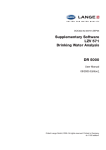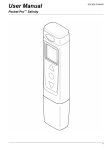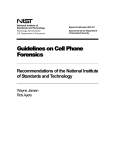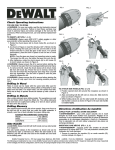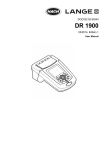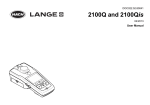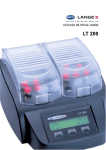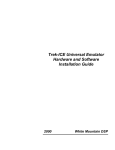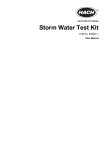Download Thermostat LT 200
Transcript
DOC022.98.00742.JAN06 LT 200 DOC022.98.00742.JAN06 Thermostat LT 200 USER MANUAL (english) January 2006, Edition 2 © Hach Lange GmbH, 2006. All rights reserved. Printed in Germany. CK/SK 42 Table of Contents Section 1 Specifications .................................................... 45 Section 2 General Information .......................................... 47 2.1 Safety Information ..............................................................47 2.1.1 Use of Hazard Information ........................................47 2.1.2 Precautionary Labels ................................................48 2.1.3 Warning .....................................................................48 2.2 General Product Information ..............................................49 2.3 Important information about the manual ............................49 2.3.1 Safety Against Risk of Fire ........................................50 2.3.2 Chemical and Biological Safety .................................50 2.4 Overview of Product/Function ............................................51 2.5 Disposal in accordance with EU directive 2002/96/EC ......51 Section 3 Installation ......................................................... 53 3.1 Unpacking the Instruments ................................................53 3.2 Front- and back view ..........................................................54 Section 4 Operation ........................................................... 57 4.1 Software Menu ...................................................................57 Section 5 Start up .............................................................. 59 5.1 Starting up ..........................................................................59 5.2 Routine operation ...............................................................61 5.2.1 Thermometer symbol ................................................61 5.2.2 Clock symbol .............................................................62 5.2.3 Beep functions ..........................................................62 5.2.4 Stop function .............................................................62 5.3 Selecting the program ........................................................63 5.4 User programs ...................................................................65 5.5 Language ...........................................................................66 Section 6 Maintenance ...................................................... 67 6.1 Cleaning the Instrument .....................................................67 6.2 Instrument test ...................................................................68 6.3 Changing the protective covers .........................................68 Section 7 Troubleshooting ................................................ 71 43 Table of Contents Section 8 Contact Information ...........................................73 Section 9 Warranty, liability and complaints ....................75 44 Section 1 Specifications Specifications are subject to change without notice. Performance Specifications Type Thermostat with one heating block or two separate heating blocks with integrated protective lid for heating cuvette tests and reaction vessels. Temperature programs COD program (148 °C, 120 min) 100 °C program (100 °C, 30, 60, 120 min) 40 °C program (40 °C, 10 min) and freely selectable 37–150 °C (no cooling) Timer programs freely selectable 0–480 min; acoustic signal when the set time expires Heating rate from 20 °C to 148 °C in 10 min (to DIN 38409-44) Temperature stability +/- 1 °C Number of cuvettes LTG082.xx.10xxx: 9 x 13 mm diameter, 2 x 20 mm diameter LTG082.xx.21xxx: left: 15 x 13 mm diameter right: 6 x 13 mm diameter, 4 x 20 mm diameter Physical and Environmental Specifications Width 250 mm Height 145 mm Depth 310 mm Weight LTG 082.xx.10xxx : 2 kg instrument, 3.5 kg packed LTG 082.xx.21xxx : 2.8 kg instrument, 4.3 kg packed Ambient conditions Operating temperature: 10–45 °C Storage temperature: -40–60 °C Relative humidity: max. 90%, non-condensing Additional technical data Mains connection 115/230 V, +5%/-15%, 50/60 Hz, protection class I Power input LTG 082.xx.10xxx : 115 V: 300 VA; 230 V: 450 VA LTG 082.xx.21.xxx : 115 V: 600 VA; 230 V: 900 VA Safety checks CE, GS and cTUVus Guarantee 2 years 45 Specifications 46 Section 2 General Information 2.1 Safety Information Please read this entire manual before unpacking, setting up, or operating this equipment. Pay attention to all danger and caution statements. Failure to do so could result in serious injury to the operator or damage to the equipment. To ensure that the protection provided by this equipment is not impaired, do not use or install this equipment in any manner other than that specified in this manual. 2.1.1 Use of Hazard Information DANGER Indicates a potentially or imminently hazardous situation which, if not avoided, could result in death or serious injury. CAUTION Indicates a potentially hazardous situation that may result in minor or moderate injury. Important Note: Information that requires special emphasis. Note: Information that supplements points in the main text. 47 General Information 2.1.2 Precautionary Labels Read all labels and tags attached to the instrument. Personal injury or damage to the instrument could occur if not observed. A symbol, if noted on the instrument, will be included with a danger or caution statement in the manual. This symbol, if noted on the instrument, references the instruction manual for operation and/or safety information. Electrical equipment marked with this symbol may not be disposed of in European public disposal systems after 12 August of 2005. In conformity with European local and national regulations (EU Directive 2002/96/EC), European electrical equipment users must now return old or end-of life equipment to the Producer for disposal at no charge to the user. Note: For return for recycling, please contact the equipment producer or supplier for instructions on how to return end-of-life equipment, producer-supplied electrical accessories, and all auxiliary items for proper disposal. This symbol, when noted on the product, indicated that the marked item can be hot and should not be touched without care. 2.1.3 Warning DANGER The ventilation slits in the lid must not be covered, otherwise overheating may occur. The protective lids must always be closed during operation. The surface of the heating blocks is thermally insulated. Never insert a finger into an opening, as there is a danger of suffering burns. The LT 200 thermostat should only be connected to a socket outlet with earthing contact. Be sure to use an undamaged cable. 48 General Information 2.2 General Product Information The thermostat has been designed in accordance with the current state of the technology and the acknowledged safety regulations. The manufacturer certifies that this instrument was tested thoroughly, inspected and found to meet its published specifications when it was shipped from the factory. Nevertheless, under certain circumstances users may be at risk, or the proper functioning of the instrument may be impaired. 2.3 Important information about the manual The manual contains all the information needed to enable the instrument to be operated without any problems throughout its lifespan. Such adherence results in less down-time and lower repair costs, and increases the lifespan of the instrument. Copyright The copyright to this User Manual remains with the manufacturer. The Manual contains instructions, notes and drawings of a technical nature, which may not, either in full or in part, be • duplicated • disseminated • used without authorization for competitive purposes or communicated in any other way. 49 General Information 2.3.1 Safety Against Risk of Fire Certain electrical circuits within this equipment are protected by fuses against over-current conditions. For continued protection against a risk of fire, replace fuses only with the same type and rating specified. 2.3.2 Chemical and Biological Safety DANGER Handling chemical samples, standards and reagents can be dangerous. Users of this product are advised to familiarize themselves with safety procedures and the correct use of chemicals, and to carefully read all relevant Material Safety Data Sheets. Normal operation of this instrument may involve the use of hazardous chemicals or biologically harmful samples. 50 • The user must observe all cautionary information printed on the original solution containers and safety data sheet prior to their use. • All waste solutions must be disposed in accordance with local and national law. General Information 2.4 Overview of Product/Function The LT 200 thermostat can heat solutions in round cuvettes of various sizes at 37–150 °C for a period of 0–480 minutes. The LT 200 thermostat has one temperaturecontrolled heating block or two separate ones. The small openings (diameter 13 mm) in the heating block are suitable for the HACH LANGE cuvette tests, e.g. COD and phosphate cuvettes. The larger openings (diameter 20 mm) are intended for reaction vessels. Sample preparation, e.g. the sample digestion for a number of cuvette tests, is carried out in the reaction vessels. The actual temperatures of the heating blocks and the remaining time are permanently visible in the digital display. The LT 200 thermostat has 3 permanent and 6 freely programmable temperature programs. The LT 200 thermostat comes with a multi-language support. 2.5 Disposal in accordance with EU directive 2002/96/EC How to prepare an electrical instrument for disposal: • remove any cuvettes that are still in the instrument 51 General Information 52 Section 3 Installation DANGER Only qualified personnel should conduct the tasks described in this section of the manual. 3.1 Unpacking the Instruments 1. Remove the LT 200 thermostat and accessories from the shipping container. 2. Do not push any loose objects under the instrument, as this could affect its stability. 3. Inspect each item for any damage that may have occurred during shipment 4. Do not send the instrument back without previous arrangement. 53 Installation 3.2 Front- and back view Figure 1 Front view of the LT 200 thermostat 1 Protective lid 5 Touch-sensitive Keys 2 20 mm digestion cuvettes 6 Display 3 13 mm cuvette tests 7 Left heating block 4 Right heating block 54 Installation Figure 2 Back view of the LT 200 thermostat 1 On/Off switch 2 Plug in power supply 3 Nameplate 55 Installation 56 Section 4 Operation 4.1 Software Menu SELECT BLOCK LEFT/RIGHT Select the heating block. SELECT PROGRAM 100 ° Selection of 100 °C temperature program. Heats cuvettes for 30, 60, or 120 minutes at 100 °C. DIGESTION PERIOD? 120’/60’/30 Selection of temperature time. 100 °C: 100 °C 60’ OK For example, the “100 °C, 60 minutes” setting is needed to digest samples using the LCW 902 Crack Set. Start the program with OK. SELECT PROGRAM COD Selection of COD Temperature program. Heats cuvettes for 2 hours at 148 °C. In the cooling phase, 4 beeps indicates that the cuvettes have cooled to 80 °C. Remove and carefully invert the cuvettes several times, before allowing them to cool further in a rack. COD: 148 °C 120’ OK Start the program with OK. SELECT PROGRAM 40 ° Selection of 40 °C temperature program. Heats cuvettes for 10 minutes at 40 °C. 40 °C: 40 °C 10’ OK SELECT PROGRAM PRG1 Start the program with OK. Programming a user-specific temperature program (5.4 User programs auf Seite 65). 57 Operation 58 Start up Section 5 Start up 5.1 Starting up Place the thermostats on a stable, level, heat-resistant surface. Plug one end of the power supply into the back of the thermostat, below the power switch, and plug the other into an earthed mains power socket (115/230 Volt +5%/-15% / 50/60 Hz). Switch on the thermostat by pressing the power switch on the back. Note: Do not switch the instrument off and on in rapid succession. Always wait about 20 seconds before switching the instrument on again, otherwise you may damage the electronic and mechanical systems. The first time the instrument is turned on, the language selection screen will appear (section 5.5 on page 66). After initialization the instrument is ready for operation. 59 Start up . Figure 3 Display and Keys of the LT 200 thermostat 1 Display 2 Touch-sensitive Keys The instrument is operated using three touch-sensitive keys located below the display (Figure 3). The function of the key depends on the display. If no function is shown for a specific key, that key is not currently active. After the instrument has been initialized, the display always shows the most recent setting of the temperature programs. 60 Start up 5.2 Routine operation • Prepare the cuvettes as described in the working procedure. • Switch on the thermostat and open the protective lid. • Place the cuvettes in a heating block and close the protective lid. 1. Select the required temperature program using the appropriate keys. • The thermostat heats to the set temperature and the time automatically counts down to zero. • The actual temperature and the remaining time are permanently visible in the display. • Three beeps indicate that the temperature program is finished; the thermostat cools. 5.2.1 Thermometer symbol Thermometer symbol Description Heating block is heating. Heating block has reached the set temperature. Heating block is cooling. 61 Start up 5.2.2 Clock symbol Clock symbol Description The remaining time counts down to zero. 5.2.3 Beep functions Beep function Description 1 beep Thermostat is ready for operation after initialization. 2 beeps Set temperature has been reached. 3 beeps End of temperature program. 4 beeps COD program - cooling phase 80 °C - remove cuvettes and invert a few times. 5.2.4 Stop function The stop function can be used to terminate a temperature program at any time. 1. Select the program you want to stop. 2. Terminate the temperature program with STOP. Note: Press the UP ARROW KEY to allow the temperature program to proceed without being terminated. 62 Start up 5.3 Selecting the program The temperature programs can be selected totally independently for the right and the left heating blocks. If a change of setting is selected, the user is prompted to specify whether the change concerns the right or the left heating block. A choice of 3 permanently programmed temperature programs then appears and the user selects one by pressing the appropriate key. The COD program heats cuvettes for 2 hours at 148 °C. In the cooling phase, 4 beeps indicate that the cuvettes have cooled to 80 °C. At this point, the cuvettes must be removed and carefully inverted a few times. This setting is suitable for all COD cuvette tests. Note: Press OK to confirm your selection or press the UP ARROW KEY to return to the program selection screen. 63 Start up The 100 °C program heats cuvettes for 30, 60 or 120 minutes at 100 °C. The setting “100°C, 60 minutes” is needed, for example, to determine phosphate and chromium or for digesting heavy metals. Note: Press OK to confirm your selection or press the UP ARROW KEY to return to the program selection screen. The 40 °C program heats cuvettes for 10 minutes at 40 °C. This setting is used for, for example, enzymatic food tests. Note: Press OK to confirm your selection or press the UP ARROW KEY to return to the program selection screen. 64 Start up 5.4 User programs The LT 200 can accommodate 6 user programs in the storage locations PRG1 to PRG6. The following example illustrates how users can program their own temperature programs: 1. Press key below PRG1. 2. Press key below PROG. 3. Press PRG1 to assign a 4-character program name. Press this key for several times to run through the digits and letters. Note: Press the RIGHT ARROW KEY to move the cursor to the next position. Press OK to confirm the entry. 4. Press the UP AND DOWN ARROW KEYS to set the temperature to a value between 37 °C and 150 °C. Note: Press OK to confirm the entry. 65 Start up 5. Press the UP AND DOWN ARROW KEYS to set the time to a value between 0 and 480 minutes. Note: Press OK to confirm the entry. 6. Press OK to confirm the program. Note: The program can be changed by pressing PROG. Note: Press the UP ARROW KEY to return to the program selection screen. 5.5 Language If this setting needs to be changed, press the left key while you switch on the instrument. Press the RIGHT ARROW KEY to scroll through the menu. Press the corresponding key to select the required language. The thermostat is automatically initialized and the instrument is then ready for operation. 66 Section 6 Maintenance 6.1 Cleaning the Instrument The thermostat is a maintenance-free instrument. To ensure reliable and precise operation, it must be kept clean. • Before cleaning the thermostat you should switch it off, unplug the power cord and allow the instrument to cool. • Wipe the instrument with a soft, damp cloth. Make sure that no water penetrates into the instrument during cleaning! If a cuvette overflows or bursts, or small amounts of liquid are spilled, proceed as follows: • Switch off the thermostat, unplug the power cord and allow the instrument to cool. • Draw off the liquid with a pipette, avoiding any contact with the skin. DANGER Caution should be exercised with acids and lyes, as they can cause burns. • Transfer liquid residues to an empty cuvette for proper disposal. • Remove broken glass with tweezers - avoid any contact with the skin. 67 Maintenance 6.2 Instrument test The temperature shown in the display corresponds to the temperature in a closed LANGE cuvette filled with an aqueous medium. During the heating phase, the real block temperature in the vicinity of the heater may be higher than the temperature shown in the display. An empty LANGE cuvette (LCW 906), glycerol (approx. 5 ml) and a stem-type thermometer calibrated over the range from 95 °C–155 °C (type 67C to ASTM) are needed to check the block temperature. • Fill the cuvette with glycerol at room temperature and insert the thermometer until it touches the bottom of the cuvette. • When the thermometer is in the cuvette, the level of the glycerol must be 62 mm +/- 0.5 mm. • Insert the cuvette in the centre opening of the second row of the test block. • Start the temperature program for 100 °C, 60 min for this block. When the heating phase is complete, the temperature shown by the thermometer should be equal to the temperature shown in the display. 6.3 Changing the protective covers To change the protective covers, proceed as follows: 1. Half open the protective cover (approx. 45 °) and take hold of it above the external hinge with your thumb inside (Figure 4). 68 Maintenance 2. Press your thumb against the inside of the cover and carefully bend the cover upward and lift it out of its mounting (Figure 5). 3. Lift the protective cover slightly and take the other side out of the mounting. 4. Fit a new protective cover by carrying out the above steps in the reverse order. Figure 4 Changing the Protective lid (Step 1) Figure 5 Changing the Protective lid (Step 2) 69 Maintenance 70 Section 7 Troubleshooting BLOCK IS TOO HOT! PLEASE WAIT OK The temperature of the heating block is higher than the target temperature. Wait until the heating block cools. INIT ERROR The thermostat is defective. Please contact Customer Service. 71 Troubleshooting 72 Section 8 Contact Information Orders/Repair service Please contact your representative: HACH LANGE GMBH Willstätterstraße 11 D-40549 Düsseldorf Tel. +49 (0)2 11 5288-0 Fax +49 (0)2 11 5288-143 [email protected] www.hach-lange.de HACH LANGE LTD Pacific Way Salford Manchester, M50 1DL Tel. +44 (0)161 872 14 87 Fax +44 (0)161 848 73 24 [email protected] www.hach-lange.co.uk Information Required • Hach account number (if available) • Billing address • Your name and phone number • Shipping address • Purchase order number • Catalog number • Brief description or model number or series-production number • Quantity 73 Contact Information 74 Section 9 Warranty, liability and complaints The manufacturer warrants that the product supplied is free of material and manufacturing defects and undertakes the obligation to repair or replace any defective parts at zero cost. The warranty period for instruments is 24 months. If a service contract is taken out within 6 months of purchase, the warranty period is extended to 60 months. With the exclusion of the further claims, the supplier is liable for defects including the lack of assured properties as follows: all those parts that can be demonstrated to have become unusable or that can only be used with significant limitations due to a situation present prior to the transfer of risk, in particular due to incorrect design, poor materials or inadequate finish will be improved or replaced, at the supplier's discretion. The identification of such defects must be notified to the supplier in writing without delay, however at the latest 7 days after the identification of the fault. If the customer fails to notify the supplier, the product is considered approved despite the defect. Further liability for any direct or indirect damages is not accepted. If instrument-specific maintenance and servicing work defined by the supplier is to be performed within the warranty period by the customer (maintenance) or by the supplier (servicing) and these requirements are not met, claims for damages due to the failure to comply with the requirements are rendered void. Any further claims, in particular claims for consequential damages cannot be made. Consumables and damage caused by improper handling, poor installation or incorrect use are excluded from this clause. 75 Warranty, liability and complaints 76






































